Recessed lights or commonly called pot lights are quite technical fixtures. The entirety of their good functional life depends on their structural components and proper installation.
These lights are subtle, sleek and very efficient, the structural components make them efficient and versatile. In a sense that they can fit into any ceiling design and can change the look and feel of the place entirely.

To choose the right LED recessed light fixtures for your home here are a few tips which might come in handy.
1. Check the ceiling design
It is important to note that recessed lights are widely used as ceiling lights for general lighting layout thereby it is necessary to check the design of the ceiling you're about to install recessed light fixtures in. These lights are tiny and the housing of these fixtures sits inside the ceiling hence they are called recessed lights.
There are various ratings for different ceiling designs which are:
This type of housing is in direct contact with insulation
This type of housing is not in contact with insulation, there should at least be a3-inches clearance between the housing and ceiling
Airtight housing restricts airflow between the room and attic above
This housing is used in ceilings with joists
This housing allows the light to be angled in a sloped ceiling design
This housing is used in newly constructed rooms or in places where the ceiling is yet to be installed.
- Remodeled ceiling housing
This housing is for remodeled homes or wherever recessed lights are to be installed in an existing ceiling.
2. Prepare a layout of the room
It is necessary to prepare a layout of the room beforehand to avoid any inconvenience during or after installation. Although these fixtures are tiny, they are in fact pretty tacky and there are a few things to consider prior the installation such as
- Height of the ceiling of the room,
- the layout of the room for example, each room of the house differs in its function and setting.
These are important factors which contribute to the layout as recessed lights allow layering of light. In the living room, kitchen or bedroom these lights can be adjusted for general lighting, task lighting or accent lighting layout depending on the need of the room. In kitchen task lights over the counter are necessary which can be layered with pendants or scones. similarly, in living room shelves or any collectibles can be displayed with accent lighting or task lights over the study area help with focusing on tasks on hand.
Preparing a layout save a lot of trouble with recessed lights sizing, placement and number of fixtures required in total. It helps determine the correct placement of a single fixture to avoid overlapping of light from neighbouring fixtures.
3. check the trim design
The most important feature of a recessed light fixture is its trim. There are various trim designs available for different light layouts. The function of a trim is to direct the light out of the fixture and it's the only visible part of the light. The different kinds of trim designs are
baffle trim, open trim and reflector trim; for general lighting.
Eyeball trim, gimbal trim; for accent lighting.
Pinhole trim, wall wash trim; for task lighting.
4. Line Voltage or Alternate Voltage
LED recessed lights have the option where for general lighting layout they can run on the line voltage which is the same as the rest of the house and for task or accent lighting they can operate on altered voltage. This saves up a lot of energy.
5. Use of LED bulbs
Traditionally halogen lamps are used in recessed light fixtures because they are brighter as compared to other lamps but recently they have been replaced by LEDs because they are highly efficient.
There are significant advantages of using LED lamps over traditional lamps.
LEDs are highly efficient as they consume less power and produce more light. They produce less heat and have a significant impact on electricity costs. The lifespan of LED lamps is around 4 or 5 years of constant usage which means lesser maintenance and replacement costs.
Conclusion:
These five approaches conclude the usage of led recessed lights. In order to get the most out of these light fixtures without any inconveniences, these are the few things that must be considered before purchasing these fixtures.
